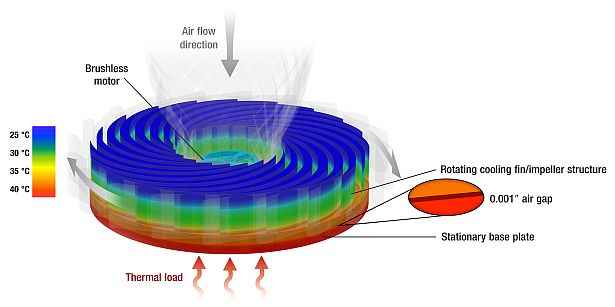Sandia Cooler introduces concept of a spinning heat sink

Generally, CPU cooling hardware doesn’t conjure up a lot of excitement. However, what just walked out of the door at the Sandia National Laboratories in Livermore, California is sure to create a lot of excitement. Along with the extra efficient cooling comes the promise of faster processing speed for laptops and desktops!
Researcher Jeff Koplow has designed this heat sink, which is the fan in itself. The Sandia Cooler, also known as the “Air Bearing Heat Exchanger”, is designed in such a away that the metal blades sit right above the heat source. This new heat sink design cuts through the warm air in such a way that air turbulence is produced, helping with the dissipation.
[RELATED_ARTICLE]
The heat moves away quicker, and allows the cooler air to have a better effect since the “dead air” problem has been completely dealt with. Also, the design creates airflow in such a way that dust gets pushed away from the heat sink, rather than getting sucked into it. Dust accumulation is one of the problems caused by the design of current heat sinks.
Traditionally, CPU heat sink designs featured a metal heat sink and a fan to push out the heat generated by the CPU. However, that design wasn’t very efficient since a layer of dead air would cling on to the heat sink. This layer was essentially some part of the warm air, and in a perfect scenario, needed to be cleared out. Power limitations (of the fan) and the basic design of the heat sinks made cooling less efficient as more and more ‘dead air’ blocked the path of the cooler air.
The Sandia Cooler, if implemented in desktop PCs and Laptops, will allow for the use of much faster processors, while running cooler at the same time.
Also read,

